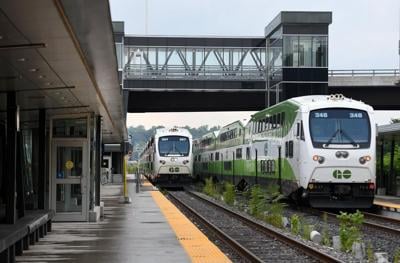Allandale25
Senior Member

GO Transit’s Hamilton ridership statistics still shifting post-pandemic
GO transit’s ridership statistics still shifting post-pandemic
GO [T]ransit’s Hamilton ridership statistics still shifting post-pandemic
Increase in West Harbour GO trains have resulted in boon for terminal
Sept. 7, 2024

West Harbour GO has nearly eight times the number of riders than in 2019 following schedule change.
The Hamilton Spectator file photo
By Kate McCullough Reporter
Nearly eight times the number of people use West Harbour GO Station than five years ago, Metrolinx says.
Currently, an average of 886 people a day board and disembark trains at the North End terminal, compared with just 93 in 2019.
The steep increase is largely due to a schedule change five years ago, in which the transportation company more than doubled service at its newest station.
Before September 2019, the west harbour saw just eight trips — four each eastbound and westbound — per day, spokesperson Andrea Ernesaks said in an email.
Now, there are 40 trips daily out of the station, 20 in each direction.
Meanwhile, the area’s two other stations continue to recover from pandemic losses.
Ridership at all local stations plummeted when the COVID-19 pandemic hit, as thousands of riders stopped commuting when workplaces and class shifted online.
“The transit landscape has undergone a significant transformation post-pandemic, and we have worked to adapt to these evolving patterns,” Ernesaks.
The number of riders dropped from 93 in 2019 to 70 in 2020 at West Harbour, from 818 to 225 at Hamilton GO Centre and from 2,497 to 698 at Aldershot GO in Burlington.
West Harbour GO service was cancelled altogether for a period during the pandemic, while GO Centre continued to operated with limited service.
[Hamilton] Centre and Aldershot remain below pre-pandemic levels, averaging 2,284 and 600, respectively, in 2024.
There was no change to GO Centre’s regular schedule between 2019 and 2024, with four morning and four evening trips.
Changes to “traditional peak-time” and work-related travel — specifically a shift from the conventional five-day work week to two or three — have affected ridership trends, Ernesaks said.
She also said GO services continue to recoup lost riders.
Reinstating services on some corridors, increased weekend “leisure” travel, and growing demand from youth and post-secondary students are among the contributing factors.
“Metrolinx continues to see ridership recovery gains following the pandemic,” Ernesaks said.




